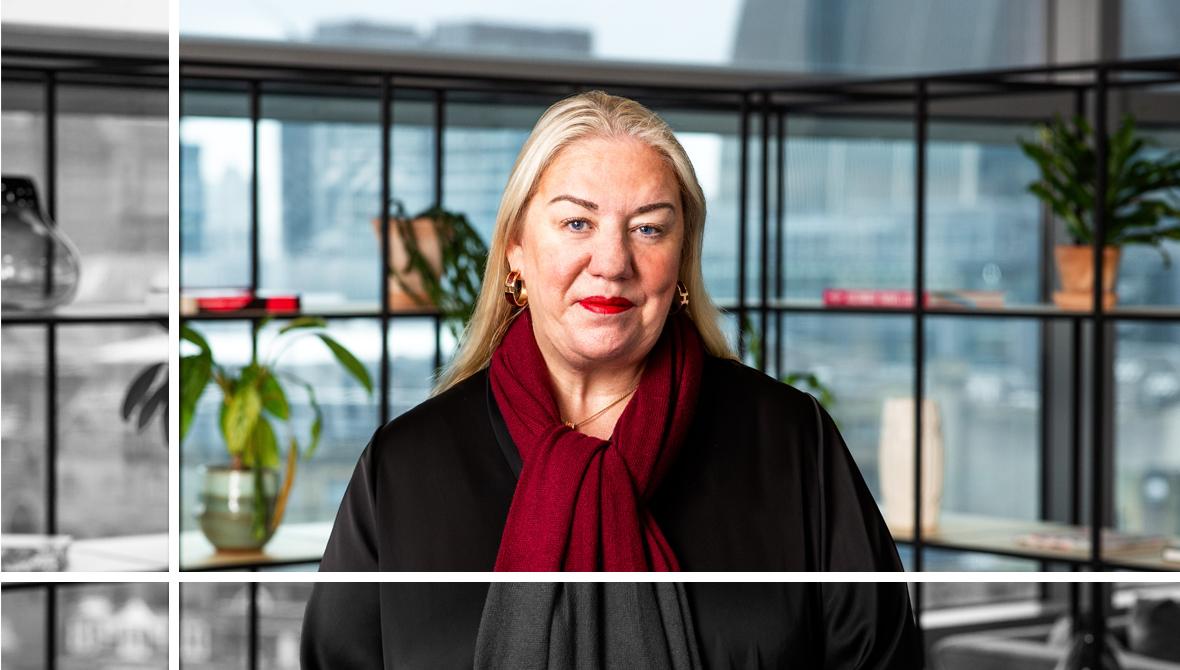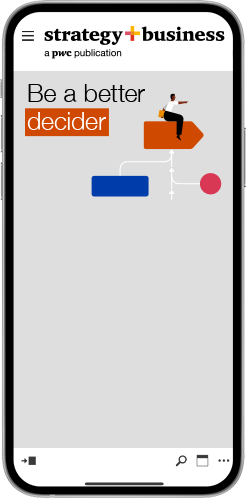The new way NatWest Group is making work better
The UK bank’s Group COO Jen Tippin explains the bold moves behind the company’s HR evolution.

This interview is part of the Inside the Mind of the CxO series, which explores a wide range of critical decisions faced by chief executives around the world.
Savvy leaders recognize that a positive employee experience helps enable business strategy. That’s why just over two years ago, Jen Tippin, group chief operating officer at the UK-based bank NatWest Group, sought to elevate the company’s employee experience to the same standard as their customer experience. Tippin and her team knew small adjustments wouldn’t be enough; they needed to be more ambitious.
“Our goal was to create a human resources model that doesn’t just react to employee needs but anticipates them,” Tippin explained. “We wanted to be set up to add value at every stage of the employee life cycle.”
The result? A new “goals and journeys” structure and way of working that aims to simplify processes, eliminate silos, and improve the employee experience. Unlike traditional HR models that separate functions like hiring, talent, training, and performance management into isolated functions, the goals-and-journeys approach brings HR personnel together to focus on what matters most to employees. A “goal” represents an experience end to end, such as joining or moving around NatWest, and works to improve it. Each goal includes “journeys” that represent how employees and prospective employees experience the moments that matter, such as being interested in a job at NatWest or their first day at work.
Now in the early stages of implementation, NatWest Group’s multiyear transformation is already delivering results to the organization and its 61,600 employees, including freeing up more than 350,000 hours for employees over the course of one year. Shared capability teams in areas like reward or performance management now collaborate with goal teams to bring deep expertise across the model. An enhanced AI-driven chatbot called AskArchie has increased query resolution. Those changes and more are proof the approach is helping the company meet both strategic goals and day-to-day employee needs.
Tippin recently sat down with strategy+business to share the behind-the-scenes challenges, innovations, and cultural shifts that have accompanied NatWest Group’s transformation so far. The following is an edited version of that conversation.
S+B:
Why
was
it
so
important
for
NatWest
Group
to
focus
on
the
employee
experience?
JEN
TIPPIN:
Post-pandemic,
we
noticed
trends
like
the
“great
resignation”
and
an
even
bigger
focus
on
employee
experience.
We
wanted
to
critically
examine
the
“moments
that
matter”
throughout
the
time
that
someone
is
with
the
bank,
from
recruitment
to
onboarding,
performance
management,
learning,
development,
and
even
exits
or
retirements.
Many of our colleagues are also our customers, so if we can provide them with a positive experience as employees, that often translates into a better experience for customers. To achieve our goals and support our customers, we need brilliant people who feel valued and empowered in their roles every day.
Many of our colleagues are also our customers, so if we can provide them with a positive experience as employees, that often translates into a better experience for customers. To achieve our goals and support our customers, we need brilliant people who feel valued and empowered in their roles every day.”
S+B:
What
approach
did
you
opt
for?
TIPPIN:
We
had
used
a
goals-and-journeys
approach
to
enhance
our
customer
experience,
and
that
led
us
to
consider
a
similar
approach
to
elevate
the
employee
experience.
We’ve
been
working
in
this
way
for
our
customers
for
many
years,
starting
with
our
retail
business
and
then
extending
it
to
the
rest
of
the
bank.
We’ve
seen
the
benefits
of
examining
the
customer
experience
from
an
end
to
end
perspective—understanding
pain
points
and
identifying
areas
for
improvement.
By
bringing
that
approach
to
how
we
support
our
employees,
we’ve
been
able
to
get
closer
to
their
actual
experience,
empowering
them
to
address
issues,
take
ownership,
and
improve
the
overall
employee
experience.
S+B:
Where
did
you
start?
TIPPIN:
We
took
our
time
to
really
test
our
thinking.
We
needed
to
define
our
goals
for
the
employee
experience,
establish
the
journeys
we
had
in
mind,
and
more.
We
spent
a
significant
amount
of
time
experimenting
in
different
areas
to
get
the
design
right.
For
example,
we
launched
a
goal
to
revamp
performance
management
early
so
we
could
test
the
model,
understand
the
necessary
capabilities,
and
figure
out
how
to
set
up
other
goals
for
success.
We also created a model optimization team to ensure we stayed true to our design. This team was crucial because it empowered the goals-and-journeys teams to take full ownership of their processes while also fostering a community to share best practices. This careful approach helped us see benefits more quickly than anticipated.
S+B:
What
are
some
of
the
steps
NatWest
Group
took
to
embed
this
model
effectively?
TIPPIN:
First,
we
established
clear
guardrails
and
standards,
which
provided
our
teams
with
set
frameworks
and
parameters
for
the
work.
These
standards
helped
people
understand
processes,
boundaries,
and
expectations,
mitigating
risks
and
making
the
entire
model
easier
to
follow.
Additionally, we translated our people strategy into tangible outcomes within HR. That formed the basis of our annual objectives and key results, guiding design choices and helping us prioritize. For example, we run “big room planning” every quarter to determine the most critical focus areas for the next quarter, ensuring that essential skill sets were allocated to high-impact areas.
S+B:
Can
you
give
us
an
example
of
an
area
NatWest
Group
has
reimagined
and
what
that
process
has
been
like?
TIPPIN:
Performance
management
has
been
a
big
focus.
We
had
a
30-year-old
performance
management
framework
that
was
very
process-heavy
and
outdated,
relying
on
cascaded
goals
and
rigid
performance
ratings.
In
redesigning
this
through
the
goals-and-journeys
method,
we
engaged
thousands
of
colleagues,
experimenting
with
how
we
set
goals,
run
check-ins,
and
make
decisions
on
performance
outcomes
and
rewards.
Feedback
on
creating
meaningful
goals,
quality
feedback,
and
coaching
has
significantly
improved
as
we’ve
made
changes.
S+B:
How
does
NatWest
Group
gather
and
incorporate
employee
feedback
into
its
new
model?
TIPPIN:
Looking
at
things
through
a
colleague’s
eyes
has
been
one
of
the
highlights
of
moving
to
the
new
model.
That
includes
listening
to
their
experiences,
what
matters
to
them,
what’s
painful
to
them,
and
getting
their
feedback
on
new
ideas.
We’ve built employee feedback into many of our experiences. Our employee-led networks and college experience squads provide insights on diversity, disability, gender, LGBT+ issues, and more. In performance management alone, 6,000 colleagues have been involved in experiments. We also conduct pulse surveys and twice-yearly in-depth surveys, which give us a detailed view of sentiment and experience across the bank.
We’ve even shelved ideas when they’ve not met the reality of what our colleagues really care about. And that’s great, because we’re listening and experimenting before investing too much of our time.
S+B:
Could
you
walk
us
through
a
specific
experiment
where
employee
feedback
helped
shape
improvements?
TIPPIN:
One
of
our
goals
was
to
revise
performance
management.
We
call
this
our
Perform
Goal. We
initially
thought
we
could
launch
all
the
changes—goal-setting,
check-ins,
rewards,
and
calibration—in
one
big
rollout.
But
feedback
showed
us
that
this
approach
would
be
overwhelming.
So,
we
adjusted
and
rolled
it
out
in
a
series
of
chapters,
giving
people
time
to
adapt
and
build
the
skills
needed.
This
longer
journey
was
necessary
for
such
a
significant
cultural
change.
S+B:
You’ve
mentioned
that
uncovering
pain
points
has
been
an
important
part
of
this
process.
Can
you
give
us
an
example
of
how
you’ve
used
that
information?
TIPPIN:
We
made
improvements
to
our
recruiting
process
based
on
pain
points—it’s
now
faster
through
simplification
and
automation.
Creating
a
job
requisition
is
now
6.5
times
faster,
allocating
a
recruiter
is
now
automated,
and
by
removing
steps
from
job
offers,
these
are
now
being
returned
nearly
twice
as
fast.
Another area is in onboarding. Line managers and new starters have told us they’d benefit from improvements to our onboarding process, wanting more automation and a simpler way to get ready for Day One. So we’ve asked colleagues to experiment with us on a digital experience that can help make this happen. We’ve already identified that this could reduce the process steps needed by 50%, and we expect to see the results of the experiment by the end of the year.
S+B:
You’ve
rolled
out
an
AI
chatbot
to
help
quickly
answer
some
employee
queries.
How
did
you
decide
on
the
right
balance
between
digital
and
human
interaction?
TIPPIN:
We’re
very
conscious
of
that
balance.
Although
we
run
many
experiments
with
AI,
including
generative
AI,
we’re
focused
on
providing
the
right
experience.
Our
approach
is
to
recognize
moments
that
matter—those
times
when
human
interaction
is
essential.
Many customers enjoy digital channels, but some prefer face-to-face interactions for complex or sensitive issues. We want technology to enhance interactions without replacing the human touch where it’s most needed. For example, generative AI helps remove repetitive manual processes, but our priority is always to strengthen, not eliminate, human-to-human connections. And our AskArchie chatbot incorporates humans and technology. We’re working hard to improve the quality and scale of the help AskArchie can provide, but if he can’t currently help a colleague resolve a query then he knows when to hand it over to a member of the team.
S+B:
How
has
streamlining
through
digital
tools
helped
you
focus
on
essential
human
interactions?
Do
you
have
an
example
you
can
share?
TIPPIN:
Absolutely.
Streamlining
has
freed
us
up
to
focus
more
on
other
capabilities,
including
skills
development,
for
example.
Two
years
ago,
we
began
offering
all
61,000
colleagues
two
days
annually
for
learning
future
skills—whether
that
be
in
data,
digital,
or
something
else.
Our
upskilling
and
reskilling
programs
help
colleagues
transition
to
growth
areas.
Our
strategy
has
become
sharper,
and
new
technology,
like
GenAI,
gives
us
a
more
holistic
view
of
a
colleague’s
skills,
enabling
better
succession
planning
and
talent
pipeline
development.
S+B:
What
kind
of
cultural
shifts
have
you
observed
since
adopting
this
model?
TIPPIN:
Transformation
doesn’t
happen
overnight.
Moving
to
the
goals-and-journeys
model
required
new
mindsets
and
behaviors,
which
we
supported
through
targeted
development
programs,
coaching,
and
accreditation.
We
also
introduced
personas
to
help
employees
relate
to
these
new
ways
of
working.
A major cultural shift has been how we’ve embraced experimentation. Now, there’s no such thing as a failed experiment—every result provides valuable data. We’ve trained our top 170 leaders to lead with this mindset, helping them learn from each other’s experiments. This culture of experimentation encourages innovation and learning, even from setbacks.
S+B:
What
specific
improvements
have
you
observed
since
implementing
the
new
model?
TIPPIN:
We’ve
seen
a
marked
improvement
in
employee
experience.
Our
engagement
survey,
“Our
View,”
shows
positive
results,
particularly
in
areas
we’ve
been
focused
on,
such
as
performance
management.
Last year, our simplification work has given back 385,000 hours to our colleagues allowing them to focus even more on our customers and their own potential, and we’re on track to exceed 820,000 hours in 2025, all of which directly correlates with higher employee satisfaction and engagement.
Our Family Friendly policy program achieved a 48% improvement in first-time query resolution, enhancing the employee experience significantly.
S+B:
Looking
ahead,
where
do
you
see
this
model
a
year
from
now?
TIPPIN:
My
vision
is
for
us
to
reach
the
next
level
of
maturity.
I
want
to
see
goals
fully
embedded,
our
objectives
and
key
results
advanced,
and
our
foundational
improvements
in
place.
We’ll
continue
to
experiment
and
refine
the
employee
experience,
ensuring
it
supports
both
our
colleagues
and
our
business
objectives.
Transformation
happens
through
lots
of
continuous
small
steps.
We’ll
know
we’re
on
the
right
path
when
we
start
hearing
colleagues
reflect
on
just
how
easy
it
is
to
work
here.
Author profiles:
- Peter Brown is PwC's Global Workforce Leader. He is a partner with PwC UK.
- Rebecca Mahoney is a senior editor of strategy+business.

